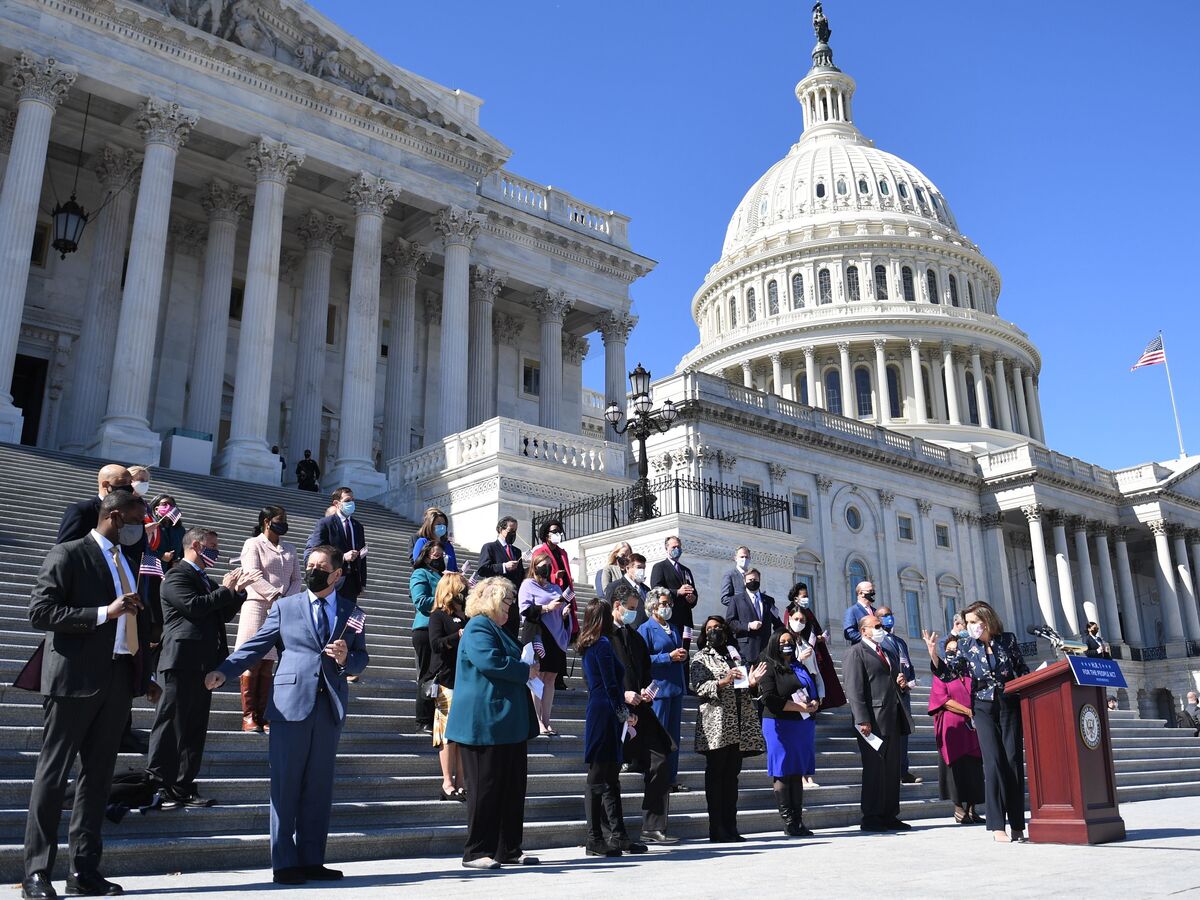Why Is the House of Representatives Limited to 435 Members

Firm Speaker Nancy Pelosi (correct) speaks exterior the U.S. Capitol in March with other members of the U.South. House of Representatives, the size of which has stayed at 435 voting members for decades. Eric Baradat/AFP via Getty Images hide caption
toggle caption
Eric Baradat/AFP via Getty Images

House Speaker Nancy Pelosi (right) speaks exterior the U.Southward. Capitol in March with other members of the U.S. House of Representatives, the size of which has stayed at 435 voting members for decades.
Eric Baradat/AFP via Getty Images
For decades, the size of the U.S. Business firm of Representatives has pitted state against land in a fight for political ability later on each census.
That's because, for the almost part, there is a number that has non changed for more than than a century — the 435 seats for the Business firm'due south voting members.
While the House did temporarily add 2 seats after Alaska and Hawaii became states in 1959, a police force passed in 1929 has gear up that de facto cap to representation.
Information technology has meant that once a decade, states have had to face up the prospect of joining a listing of winners and losers later on those House seats are reshuffled based on how us' latest census population counts rank. How those seats are reassigned besides plays a fundamental role in presidential elections. Each land's share of Electoral College votes is determined by adding its number of House seats to its two Senate seats.
For nearly of the Business firm's history, however, states did non lose representation later the national head count'due south results were released. Generally speaking, every bit the country'south census numbers grew, so did the size of the House since it was commencement established at 65 seats by the Constitution earlier the first U.South. count in 1790.
At the country's founding, many framers were concerned that the original Business firm was "way too small," according to Yale University police force professor Akhil Reed Amar.
"This might seem esoteric today, but you got to remember that the Constitution is the product of an American revolution. And that revolution was all about a key idea — no taxation without representation," says Amar, writer of the upcoming volume The Words That Made The states: America'due south Constitutional Conversation, 1760-1840. "If you're going to accept big-time revenue enhancement and anemic representation, people are going to say, 'Wait a minute. We desire to be taxed past people who know us, who look like us, who empathize the concerns of their constituents in their districts.' "
After the 1840 census — and in one of the terminal decades before the 14th Amendment ended the census'southward counting of an enslaved person as "three fifths'' of a gratuitous person — Congress did driblet the number of Business firm seats from 242 to 232. The latest census numbers showed an increase compared with the 1830 results, but Congress could only agree on a smaller House size later on Senate pushback over increasing the number of seats.
"And then information technology went back up and resumed the growth process over again," says demography historian Margo Anderson, author of The American Census: A Social History.
That growth plateaued afterward the 1920 census, when Congress, for the get-go time in history, did not pass a new law about how to use the results of the latest national tally to reshape the House.
"The apportionment system failed," explains Dan Bouk, an associate professor of history at Colgate University who has written a new report for the research institute Data & Society virtually how lawmakers in the 1920s ultimately shaped the House's current size.
Some congressional leaders at the fourth dimension pushed to get out it at 435 seats, the size information technology had grown into later on Arizona and New United mexican states joined the wedlock in 1912.
"The thing that really caused the apportionment to go hung up over and over over again throughout the 1920s was the insistence of a set of leaders that the House of Representatives could no longer grow whatever larger," Bouk says. "They said information technology's about efficiency. They didn't desire to pay for more than office space, to pay for more than Congress people and more than clerks. They believed the House couldn't exist a deliberative body if it grew whatever larger."
While those kinds of arguments against making the Business firm bigger were non new, they won out in 1929, when Congress passed the law that set up an automatic procedure for reapportioning the House based on the existing number of seats.
"There's nothing at all magical near the number 435 Congress settled on," Bouk adds.
In fact, there has been give-and-take over the decades about expanding the House, which would crave Congress to pass a new constabulary. Simply Bouk notes that the system for automatically redistributing 435 Business firm seats after each census has created "a kind of inertia that makes such changes very unlikely."
Nonetheless, Anderson, the census historian, says she's concerned almost how representative the Business firm really is at this unchanging size. A century ago, there was one member for about every 200,000 people, and today, in that location'southward one for virtually every 700,000.
"Congress has the authorisation to deal with this someday," Anderson says. "It doesn't have to be right at the census."
And information technology might have to if, for example, Washington, D.C., or Puerto Rico becomes a state.
Until then, there volition all the same exist a fight for the ability in 435.
Source: https://www.npr.org/2021/04/20/988865415/stuck-at-435-representatives-why-the-u-s-house-hasnt-grown-with-census-counts
0 Response to "Why Is the House of Representatives Limited to 435 Members"
Postar um comentário